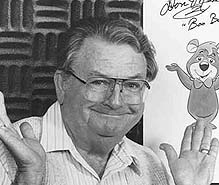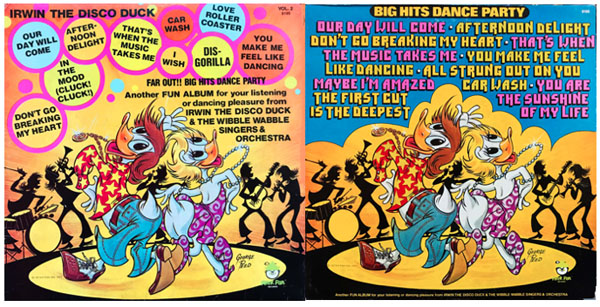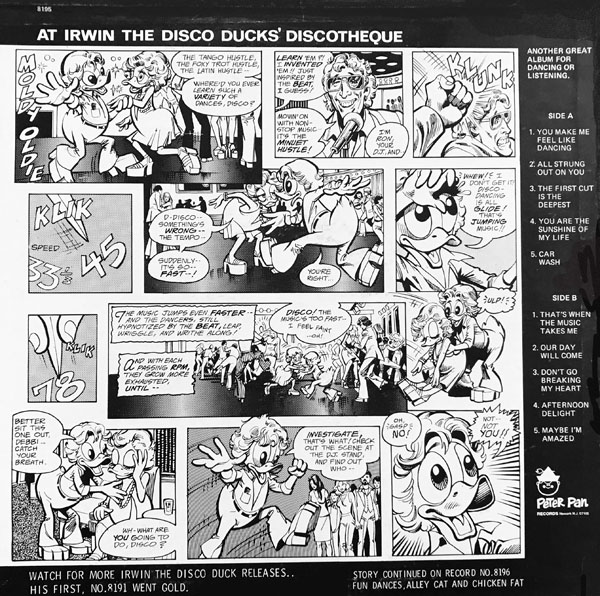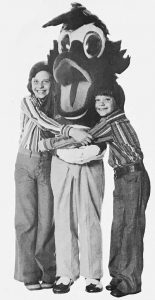From sidekick to superstar, here’s a salute to one of animation’s finest actors with a look at some unusual recordings from his career.
 Don Messick honed his craft first through his love of classic radio, then through a career in that medium’s latter days. And like the voice acting legend most closely associated with him, Daws Butler, he was an unassuming gentleman who worked hard for years, never taking his success for granted nor those who helped him get there.
Don Messick honed his craft first through his love of classic radio, then through a career in that medium’s latter days. And like the voice acting legend most closely associated with him, Daws Butler, he was an unassuming gentleman who worked hard for years, never taking his success for granted nor those who helped him get there.
According to The Magic Behind the Voices by Tim Lawson and Alisa Persons, one of Messick’s first big showbiz breaks was working for Bob Clampett, but not in cartoons. On the recommendation of Joan Gardner (Santa Claus is Comin’ to Town, Valley of the Dinosaurs, Mr. Magoo’s Christmas Carol) he was given a puppeteer position–but not for Beany and Cecil. Clampett also produced the short-lived puppet series The Adventures of Buffalo Billy, Thunderbolt the Wondercolt and The Willy the Wolf Show.
 He acknowledged Butler as the person who helped get him into animation in a very high-profile way. He was the voice of Droopy for Tex Avery in several cartoons when Bill Thompson was not available. It was similar to a voice he would after Bill Hanna and Joe Barbera chose him and Butler as the entire cast for the game-changing Ruff and Reddy cartoon series. Messick’s version of Droopy would carry over into the series as Professor Gizmo, though his voices generally were not imitations and impressions.
He acknowledged Butler as the person who helped get him into animation in a very high-profile way. He was the voice of Droopy for Tex Avery in several cartoons when Bill Thompson was not available. It was similar to a voice he would after Bill Hanna and Joe Barbera chose him and Butler as the entire cast for the game-changing Ruff and Reddy cartoon series. Messick’s version of Droopy would carry over into the series as Professor Gizmo, though his voices generally were not imitations and impressions.
Messick was the perfect vocal counterpoint to Butler’s characters, whether a sidekick like Boo-Boo or a long-suffering opponent like Ranger Smith. His approach, like Butler, was to approach the voices as characters, and quite often he voices the more grounded and authoritative roles, like Papa Smurf and Dr. Benton Quest (after John Stephenson). Even Arnold the newsboy, Fred Flintstone’s pint-sized nemesis, was not played by Messick as a silly character, which gave Alan Reed (an idol of Messick’s) more room for comic reaction. Even when he began to play more leads, Messick was the quintessential ensemble player, the Betty White of voice acting.
 Perhaps his greatest ability was to voice a number of canine cartoon characters while giving them interesting variations on a theme of whimpers, chuckles and barks. Some of these dogs could speak with the addition of “R’s” to words, as in Astro’s immortal “Rye, Reorge” and of course, his Scooby-Doo characterization is now in the capable hands of yet another legend, Frank Welker. Messick’s Precious Pupp, Muttley and one of Barbera’s favorites, Snuffles, are also classics of the genre.
Perhaps his greatest ability was to voice a number of canine cartoon characters while giving them interesting variations on a theme of whimpers, chuckles and barks. Some of these dogs could speak with the addition of “R’s” to words, as in Astro’s immortal “Rye, Reorge” and of course, his Scooby-Doo characterization is now in the capable hands of yet another legend, Frank Welker. Messick’s Precious Pupp, Muttley and one of Barbera’s favorites, Snuffles, are also classics of the genre.
His work made its way to recordings as early as Hanna-Barbera started making records based on their TV shows, from the Ruff and Reddy soundtrack album to Hanna-Barbera’s Atom Ant LP, “Muscle Magic” LP and beyond. He and Butler wrote as well as starred with Doug Young in two original Colpix vinyl productions, Huckleberry Hound and The Ghost Ship and Quick Draw McGraw and The Treasure of Sarah’s Mattress.
His voice acting roles added into the hundreds, not just for Hanna-Barbera but also for Rankin/Bass, Disney, Warner and others, as well as an on-camera role on the short-lived sitcom The Duck Factory with Jim Carrey.
Along the way, he recorded for children’s record companies. One of his most successful and best-selling record series had only a passing connection to animation. On four albums for Peter Pan Records, Don Messick was “Irwin the Disco Duck”.
 In 1976, when disco music was becoming so popular that kids were starting to buy the records, Peter Pan was the first children’s record company to get on the bandwagon. Rick Dees had struck gold with a novelty song called “Disco Duck,” using a Donald-type quack voice. Dees’ single and album crossed into the kid’s market.
In 1976, when disco music was becoming so popular that kids were starting to buy the records, Peter Pan was the first children’s record company to get on the bandwagon. Rick Dees had struck gold with a novelty song called “Disco Duck,” using a Donald-type quack voice. Dees’ single and album crossed into the kid’s market.
Peter Pan, which was and still is a lean, family-run company, was able to move quickly. The same year, veteran children’s record producer Ralph Stein, whose records date back to the early fifties on the Cricket, Happy Time and Golden labels, produced an album for Peter Pan called Disco Duck Dance Party featuring Irwin the Disco Duck (with his girlfriend Debbi on the cover). It was a collection of ten sound-alike pop hits bridged by an unidentifiable Donald-type DJ with a canned party crowd.
Ralph Stein had known Don Messick for at least ten years. They had recorded an album for Golden Records in 1967 (more about that soon) and Stein had just produced the first Scooby-Doo records for Peter Pan in 1977. All but Casey Kasem from the TV cast were on the first album and read-alongs. Kasem would participate in the second album as well as the Christmas album, which was discussed in this Animation Spin.
This is the only Peter Pan Scooby-Doo story that was not released on an LP:
Peter Pan’s Disco Duck Dance Party became a gold record and was seen in stores alongside Disney and Sesame Street’s biggest albums. In 1977, a second album was released: Big Hits Dance Party Volume Two, with ten more pop songs. Again, the duck voice cued all the songs—but not for long.
Big Hits Dance Party Volume Two was revised in several ways. The quacky duck voice was replaced for Don Messick’s debut as Irwin. Three songs from the earlier album were replaced with three new songs. The back cover reflects the changed tracklist but is identical otherwise. The front covers of both have the same character art but the yellow/orange design of the first issue was changed to a predominantly blue look listing the revised songs.

For Irwin, Messick chose a voice similar to Arnold the newsboy or Scrappy-Doo, with occasional giggles like Chief Crazy Coyote. The script was made a little more verbose because Messick’s voice could enunciate better than the previous Duck voice. The album ends with “Maybe I’m Amazed,” a song originally recorded by Paul McCartney (and “The Wings,” as Irwin calls the band). On the Messick version, Irwin tells listeners to be sure and get his previous album—and says the catalog number!
Most of the Irwin art was done by Peter Pan’s most prolific artist, George Peed, brother of Disney story artist Bill Peet. Peed also illustrated the Disneyland LP covers for Snow White (the swirling design) and Peter Pan (the cover with Peter looking through the window), and several Disney merchandise items.
The back covers of two Irwin albums (Alley Cat and Chicken Fat and Big Hits Dance Party, Volume Two) tell a disco comic adventure story that continued from one album cover to the next. This art is by one of the world’s most renowned comic book artists and creative advocates, Neal Adams. He did a gallery of spectacular covers and read-along books for Peter Pan and its Power Records label. Someone was helpful enough to put together this impressive list.


Big Hits Dance Party Volume Three (1977) removes the party atmosphere and the crowd noise, placing Irwin on a radio show in the style of Casey Kasem, even reading a letter from a listener. Peter Pan delivered the best quality possible for the music, considering that these were children’s records made at a fraction of the cost of the records they were imitating. The label would book various studio musicians, club groups and touring bands to perform the songs, looking for talent that specialized in the hits of the day. Producing ten songs with different sounds and arrangements on one disc, even with uncredited “work for hire” talent, was expensive. These albums were premium-priced by children’s record standards, like their Disney and Sesame Street premium counterparts.
 The songs were also more reflective of late seventies AM radio in general than simply disco music. There were rock and easy listening songs included in each batch of ten. Peter Pan even tried to launch a female vocalist series with songs made famous by Linda Ronstadt, Melissa Manchester, Helen Reddy and others called Blue Bayou with “Dee Jane and the Music Makers.” The album was quite good but there were no follow-ups.
The songs were also more reflective of late seventies AM radio in general than simply disco music. There were rock and easy listening songs included in each batch of ten. Peter Pan even tried to launch a female vocalist series with songs made famous by Linda Ronstadt, Melissa Manchester, Helen Reddy and others called Blue Bayou with “Dee Jane and the Music Makers.” The album was quite good but there were no follow-ups.
Irwin continued in popularity, however, to the point of Peter Pan having a costume made so he could make personal appearance and pose for photos, including a few on his albums. With Don Messick continuing in the role Irwin hosted a 1977 Christmas and New Year’s Party album, bringing back the crowd sounds to simulate a celebration. This album was dominated by holiday tunes with a disco beat instead of popular hits. We talked about this album in an earlier Animation Spin.
With the new year came a new name. Irwin was still selling records but Peter Pan may have been seeing kid’s interest in disco songs giving way to music from Star Wars and Close Encounters of the Third Kind. To take advantage of both trends, Peter Pan released 1978’s Duck Wars Big Hits Dance Party with Don Messick as Irwin the “Dynamic” Duck. From that point, the theme of the album would determine whether Irwin was “Disco” or “Dynamic.”
After Duck Wars, an unidentifiable, generic voice hosted Disco Fever for All Ages (1978). The voice sounds a little like Peter Pan’s “Barney the Book Bear,” with a slight electronic modulation.

East coast voice acting legend Bob Kaliban took the role for all the remaining albums. A total of thirteen Irwin albums were released between 1976 and 1980. Not a bad run.
Jim’s Fairy Tales – Narration and Voices by Don Messick
One of Don Messick’s other unusual recorded projects was also produced by Ralph Stein in 1967 for Golden Records. Jim’s Fairy Tales is a gentle, unpretentious group of short stories by author James McGhee Johnson about an enchanted forest filled with nice little magical creatures and animals, all voiced by Messick. The album runs for almost an hour, taking its time weaving stories about Half-Inch Fairy, Wee Elf, their engagement and wedding preparations. The characters come in all colors, as this was a mid-sixties effort to foster peace and friendship. It might seem a little dated in these attempts, but its heart was in the right place at the time. The goose in the story sounds very much like the Rubbles’ pet, Hoppy the Hopparoo.


 GREG EHRBAR is a freelance writer/producer for television, advertising, books, theme parks and stage. Greg has worked on content for such studios as Disney, Warner and Universal, with some of Hollywood’s biggest stars. His numerous books include Mouse Tracks: The Story of Walt Disney Records (with Tim Hollis). Visit
GREG EHRBAR is a freelance writer/producer for television, advertising, books, theme parks and stage. Greg has worked on content for such studios as Disney, Warner and Universal, with some of Hollywood’s biggest stars. His numerous books include Mouse Tracks: The Story of Walt Disney Records (with Tim Hollis). Visit 






















































There was also a very obvious puppet show clone of “Time for Beany” known as “Adventures of Patches.” The one example I’ve seen has Messick as the narrator and Patches (the Beany equivalent) and Larry Harmon as his Cecil-parallel sidekick Wacky Rabbit.
Don Messick was the first cartoon voice actor whom I could reliably identify in any role, even when I was a child, whether he was playing a teenager, a professor, an announcer, an animal, an alien, or a robot. Those early Hanna-Barbera cartoons were a big part of my childhood, and his voice was a very special part of them. So his reading of Jim’s Fairy Tales affected me very deeply. It was like having a beloved babysitter step out of the mists of time, read me a bedtime story and tuck me in. I also loved the soundtrack with its wonderful arrangements of Baroque music for woodwinds, harp and vibraphone. Beautiful!
Betty White would have turned 100 in two weeks. She made me laugh many times over the years, but never as hard as when she guest starred on an episode of Family Guy, in which she narrated the audiobook version of one of Peter’s erotic novels. “I’m Betty White reading ‘The Hot Chick Who Was Italian or Maybe Some Kind of Spanish’ by Peter Griffin. Chapter One. Oh God, you should have seen this one hot chick! She was totally Italian — or maybe some kind of Spanish!”
Good night — or as the elves and fairies say, Happy Day!
Don Messick was at an animation art gallery in a far Chicago suburb when I met him, many years ago. The funniest part of his talk was when he did various voices. I got cold chills – but of pleasure – when he suddenly turned his “Dr. Quest” voice on and yelled, “Get down, Jonny!” I watched a small kid in the audience who was watching Messick perform for all of us in the gallery. This kid’s eyes almost popped out of his head as he saw – and heard – an old man become “Scooby-Doo” and other characters. That show was a real treat!
Why didn’t “The Duck Factory” ever rate a DVD release? Despite presenting a Saturday morning cartoon studio with an impossibly small staff (a common issue with workplace sitcoms), it had a superior cast and a lot of good stuff that would have sorted itself out in more episodes. Messick certainly could have made a career of acting on camera if he weren’t in such demand as a voice artist.
I only remember seeing a few episodes of that show. Did it last a full season? I’d like to see some of them again.
You can watch the whole series on YouTube:
https://www.youtube.com/playlist?list=PLwVbRQceKdUBQ8cDHlBXMoZvLLYqcLsoy
That two-page comic story was drawn by Neal Adams and the artists renting tables at Neal’s Continuity Studios.
Oops. I can read but I didn’t read that. Sorry, Greg!
Disco Duck!
Don Messick also did an alien voice in an episode of “The Invaders” titled “The Mutation” though it’s not credited on I.D.M.B..
I had the pleasure of seeing Don Messick at a lecture series sponsored by the Stay Tooned animation gallery in suburban Chicago back in the ’90s. As a Transformers fan I was most interested in his anecdotes about the TF movie and how many takes the voice director wanted for every line, which led to a wonderful piece of gallows humor: that Wally Burr had worked Orson Welles to death.